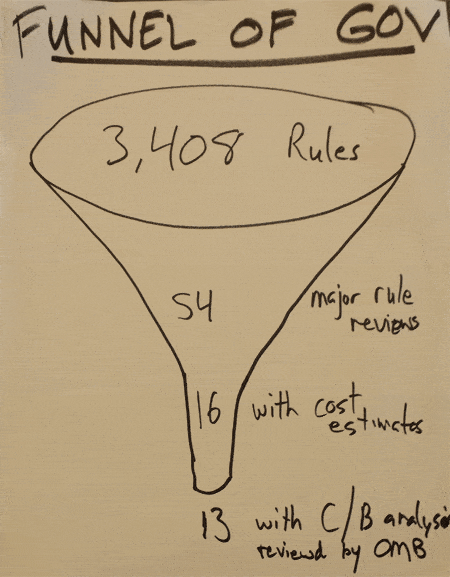Oversight Hearing Will Find Federal Regulatory Transparency Quite Opaque

The 2015 edition of White House Office of Management and Budget’s (OMB) annual Draft Report to Congress on the Benefits and Costs of Federal Regulations was latest we’ve seen from the “most transparent administration in history.”
Historically, the report has usually appeared in March, typically by April at the latest. There were September arrivals in Bush's last and Obama's first years. But the 2015 draft didn’t appear until October 16. The final edition just appeared last week, and the Draft 2016 one is now due.
Fittingly, this week, the House Oversight and Government Reform Committee’s Subcommittee on Government Operations (Chairman Mark Meadows, R-N.C.) is conducting a hearing on “Accountability and Transparency Reform at the Office of Information and Regulatory Affairs.”
In the new final report, the Obama administration maintains its fiscal year 2014 (October 1, 2013–September 30, 2014) executive agency “major” rules delivered benefits of up to $22.8 billion annually, while costing $3.0 billion to $4.4 billion annually (2010 dollars, p. 23).
Unsurprisingly for turf-conscious regulators, today’s doctrine points to large net benefits of regulation, holding that this subset of major rules (usually those anticipated to have a $100 million up-or-down economic impact) capture most regulatory costs. The OMB maintains that (p. 22):
[T]he benefits and costs of major rules, which have the largest economic effects, account for the majority of the total benefits and costs of all rules subject to OMB review.
The problem with OMB’s net-benefit breakdown being the only snapshot of the regulatory enterprise is that it includes only rules for which both benefits and costs have been expressed in quantitative and monetary terms by agencies.
Why does that matter? It matters because for the $3.0 to $4.4 billion cost component for FY2014, we are talking about only 13 rules reviewed by OMB that featured both benefit and cost analysis, as the nearby illustration shows. Yet agencies issued, by my check over at the Federal Register, 3,408 rules during the 2015 calendar year. Numerous categories and cost levels of rules fly below the radar.

Surveying the past decade, OMB pegged the cumulative benefits of major regulations issued between 2004 and 2014 at between $260.9 and $981.0 billion (pp. 9-10). Meanwhile, the estimated range for costs is pegged at $68.4 to $102.9 billion.
So the federal government’s net-benefit claims are pervasive, yet there were only 120 rules involved in this decade-long interval, a period of time over which agencies issued 36,950 rules. Most were trivial, but this is a lot to leave out; plus OMB’s surveys do not count agency guidance documents, memoranda, circulars, notices and the like that may influence the regulated public.
Despite the net-benefit number usually touted, several billion more in annual rule costs appear in OMB’s reports for a small number of rules that lack benefit estimates. These are not tallied by OMB, though I have done so here for all the reports prior to this new one; they yield another $28.8 billion since 2002 in annual costs in 2013 dollars. In the new report, a lone Health and Human Services administrative rule without a benefit tally costs $3.7 billion annually, along with two other rules costing some undisclosed amount below $100 million apiece. These alone are equivalent to the costs OMB recognizes in its claimed net benefit range.
Most pertinent, rules from independent agencies are entirely absent in OMB’s cost roundup—the Dodd-Frank rules, the Federal Communications Commission’s net neutrality regulation, antitrust intervention and so one. Independent agencies are busy, yet get little review.
Thirty-three other major rules in OMB’s report implemented transfer programs; such “budget rules” are officially considered transfers rather than regulations (pp. 27-30). That is less appropriate now that Washington fosters so much middle-class dependency on the federal government. The forfeiture of liberty as a cost, since once upon a time, college, retirement, medical care, and childcare were personal and family matters.
Clearly the “subject to OMB review” clause in the quote above is an important qualifier. Much gets left out of OMB’s net benefit assessment.
In contrast to OMB’s few billions in costs over ten years, other broader estimates exist. A 2014 National Association of Manufacturers modeled 2012 total annual regulatory costs in the economy of $2.028 trillion in 2014 dollars. My own reckoning using largely various government data sources is $1.88 trillion annually.
That we only have official word on regulations from the White House for a period that ended a year and a half ago makes the new 2016 important to see soon in this highly political year; perhaps members can ask for a preview at this week’s oversight hearing.
In a prior OMB filing on its annual report, I outlined steps the executive branch can take to improve disclosure. Congress, however, will need to act to enforce regulatory and democratic accountability in the bureaucracy.